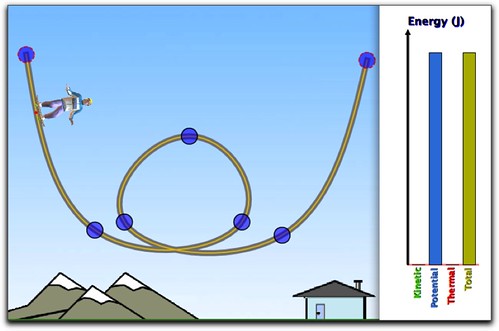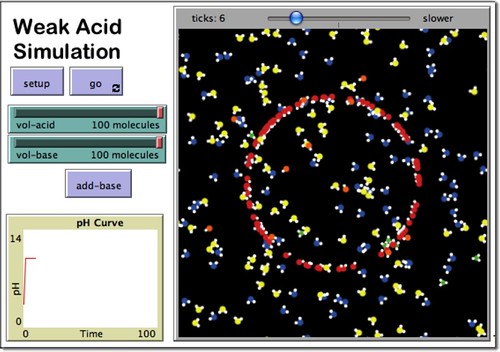| Interactive Simulations to Develop Higher-Level Science and Math Skills With Your Laptops | |
| Author: Scott Garrigan, School of Education, Wilkes University | March 8th, 2011 | |
|
How can you best engage students in higher-level science and math activities to prepare them for an unimaginable future filled with the fruits of nanotechnology, biotechnology, and genetic engineering? Most teachers and textbooks don’t address these topics that can capture the imagination of young minds. The National Science Foundation has responded by funding the development of outstanding interactive simulation systems that your students can use on Windows, Mac, and even Linux laptops at no cost. Since the simulations can be accessed through a Web browser, students can use them without your tech department installing more software on each laptop. PhET, NetLogo, and Molecular Workbench are three teacher-tested simulation systems that hundreds of thousands of students use to learn the most challenging concepts in science and math. PhET Interactive Simulations (http://phet.colorado.edu) Imaging building a skateboard park to study the conservation of energy. PhET’s Energy Skate Park simulation lets students see and graph changing kinetic and potential energies as their skater rips down the steep starting ramp, powers through a loop, and survives daring jumps. Students learn basic physics as they create the most thrilling skate tracks they can imagine. They learn proper science terminology and measurement, too. Here’s a link to Energy Skate Park with 25 teacher-designed lesson plans and translations of the simulation in 30 different languages: http://phet.colorado.edu/en/simulation/energy-skate-park. PhET interactive science simulations, developed at the University of Colorado at Boulder, provide 200 interactive models that cover most science and some math classes from elementary through university levels. Each sim focuses on one science or math concept, and it allows students to change key variables to see how the model responds. Teacher-developed activities and lesson plans accompany each of the simulations. PhET addresses both core curriculum and emerging science. Sims like Glaciers, Masses & Springs, pH Scale, and Salts & Solubility address traditional concepts. Students explore cutting-edge concepts through sims like Molecular Motors, Quantum Bounds, Stretching DNA. Some interactive simulations designed as construction or game activities are Gene Machine, Build an Atom, the Radioactive Dating Game, and Electric Field Hockey. Math simulations like Equation Grapher, Curve Fitting, Calculus Grapher, and Plinko Probability allow students to engage with math ideas in ways are not possible with paper and pencil. Professional development or coaching shouldn’t be needed for PhET because each simulation is focused on a single science or math concept and extensive lesson plans are provided. 
PhET's Energy Skate Park demonstrates conservation of energy NetLogo: http://ccl.northwestern.edu/netlogo Third graders use NetLogo’s Climate Change model to visualize how individual carbon dioxide molecules reflect infrared rays back to Earth to create a greenhouse effect. Across town, eleventh graders use NetLogo’s Weak Acid simulation to model and calculate how weak acids affect pH differently from strong acids. NetLogo includes 200 pre-programmed simulations that cover most areas of science and some areas of math such as probability. Each simulation includes clear directions for student and teacher, an explanation of the contribution of each variable, and suggestions on how students may extend the model. Originally created at MIT by Uri Wilensky, a student of Seymour Papert, the development of NetLogo has continued at Northwestern University for the past decade. Like PhET, students engage in exploring science relationships by investigating the effects of key variables. Unlike PhET, NetLogo simulations provide more accurate and more flexible models that students can explore more deeply. They can modify the models, and they can even create entirely new simulations using the built-in NetLogo computer language and interface components. Students can also design individual and networked educational games with NetLogo. The NetLogo designers have created sequences of simulations to create a comprehensive Gas Lab, Probability Lab, and Genetics Lab to promote deep understanding of complex topics that are otherwise difficult to study. NetLogo excels at agent-based modeling to explore emergent behavior, and it is used by university researchers and governments as well as by K-12 students to study complex relationships. “Agents” are independent objects such as individual molecules in a gas, an individual rabbit in a population study, or an individual person in an AIDS epidemic. This kind of experiment can only be modeled by “running” the simulation rather than by applying a mathematical formula to get a “right answer.” NetLogo simulations include the same kind of random variability that affects behavior in the physical world. The system helps students understand the importance of relationships rather than fixed answers for complex problems. 
NetLogo's Weak Acid Simulation shows individual molecular interactions. Molecular Workbench (MW) (http://mw.concord.org) Advanced science students use several Molecular Workbench nanotechnology modules to learn the quantum mechanics that drive individual atoms and molecules to self assemble in future manufacturing operations. The twelfth graders use MW’s built-in “camera” to capture the outcome of their model and the built-in report generator to record their observations and explanations. When they finish, they submit their project reports through the MW system to their teacher for grading. Across town, fourth grade students run MW’s Evolution Readiness simulations to learn the scientific processes involved in natural selection. Like PhET and NetLogo, MW supplies the science classroom with hundreds of simulations carefully designed to meet the needs of today’s K-12 learner. Teachers find MW’s interactive models invaluable to teach difficult concepts from quantum mechanics, nanotechnology, biotech, and genetics that are not addressed well in traditional textbooks and lab experiments. MW was created at the non-profit Concord Consortium, and their team of educators, researchers, and programmers create new modules every year to address emerging K-12 needs. Each module contains scaffolded lessons to guide middle and high school students step-by-step through an interactive learning process in which they complete projects that can be used as performance-based assessments. Teachers and students can create their own simulations and activities. Molecular Workbench has been nicknamed “Word for Molecules.” MW was designed to provide molecular dynamics simulations to help learn concepts in physics, chemistry, and biology, and it has been enhanced over the past decade to simulate atomic, sub-atomic, and fluid behavior as well as Newtonian mechanics. My favorite is a nanotechnology self-assembly tutorial that I’ve used to help hundreds of teachers experience the kind of “ah-ah!” moments that their students can get through Molecular Workbench activities. 
MW model of carbon nanotube adsorbtion onto gold. Note control buttons. Summary These are only three of the many high-quality interactive simulations available for your teachers and students. Real scientists use simulations to run experiments that are impossible to conduct in a laboratory; this is a new branch of science called computational science. When students use simulations, they are using computational science like real scientists; they can learn more deeply than ever before. Most teachers are ready for PhET, but they may need new skills to use NetLogo and Molecular Workbench. Contact AALF for professional development to guide your teachers in the use of tools such as computer simulations to engage students in high-level hypothesis and analysis. Scott R. Garrigan, EdD Scott Garrigan is Assistant Professor in the School of Education at Wilkes University, and Adjunct Professor, in the College of Education at Lehigh University. He is also an AALF consultant/coach |
|
« Return | Top
 |
| This article is licensed under a Creative Commons License |






